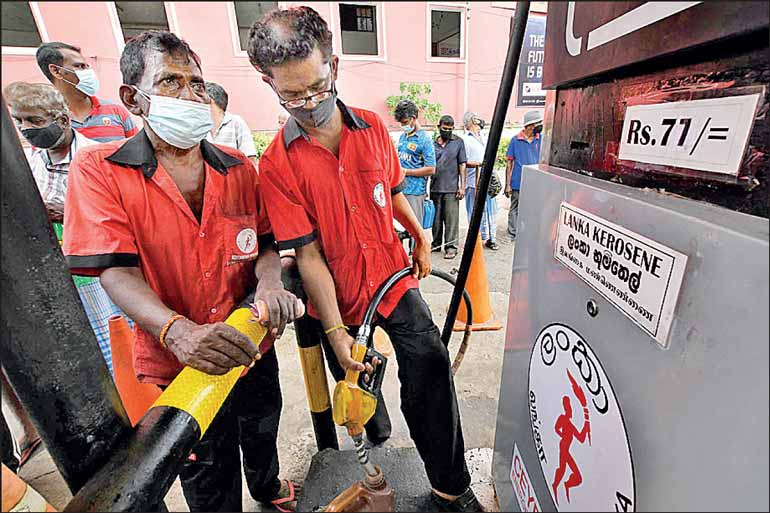Saturday Dec 27, 2025
Saturday Dec 27, 2025
Friday, 19 November 2021 00:02 - - {{hitsCtrl.values.hits}}

Light non-aqueous phase liquids (LNAPL) are hydrophobic organic liquids that are immiscible with water and less dense than water. The most common types are fuels and oils such as petrol, diesel, heating oils, and kerosene – Pic by Shehan Gunasekara
 When compared with surface water, groundwater was considered a reliable source of drinking water as it was believed to be less polluted. However, the situation has changed drastically and groundwater seems no longer a clean source of drinking water owing to many human activities that lead to its pollution.
When compared with surface water, groundwater was considered a reliable source of drinking water as it was believed to be less polluted. However, the situation has changed drastically and groundwater seems no longer a clean source of drinking water owing to many human activities that lead to its pollution.
Meanwhile, chronic kidney disease (CKD) in Sri Lanka still has an unknown aetiology and, according to reports, it is prevalent in nearly 20% of the rural population. Earlier it was suspected that consumption of groundwater polluted with agrochemicals was the cause of the disease as these agricultural areas used excessive amounts of agrochemicals. Accordingly, herbicides containing glyphosate were banned in the country assuming that to be one of the triggering agents for CKD.
Some researchers who are involved in global-level studies say that there can be many causes of CKD. Some of these factors include heat stroke leading to dehydration, a nutritionally deficient diet, mycotoxins from mould exposure, and many other toxic metals. However, we cannot deny the fact that consumption of groundwater contaminated by agrochemicals leads to health issues.
Groundwater contamination
Recently the Government banned the importation of chemical fertilisers claiming that they have been the major contributor to groundwater pollution in Sri Lanka. Although agrochemicals are often cited as the main factor of groundwater pollution there are many other sources too, which remain unnoticed.
Domestic and industrial solid waste is one of the high potential threats to the geo-environment unless properly disposed of. This would include not only food waste but also harmful wastes like plastics, chemicals, and e-waste. Many industries and hospitals contribute considerably to this type of urban waste. Another form of waste is the spreading of slurry, manure, and abattoir waste. When such solid waste is indiscriminately dumped, various hazardous compounds leach into the ground polluting soil and groundwater.
Similarly, hazardous liquid waste also is a major issue though rarely identified. Liquid waste, such as household and industrial sewage, would become a severe source of pollution if not handled properly. Petroleum is another source of groundwater pollution, which is very hard to identify. Generally, these types of contaminants are called light non-aqueous phase liquids (LNAPL).
How LNAPLs contaminate groundwater
Light non-aqueous phase liquids (LNAPL) are hydrophobic organic liquids that are immiscible with water and less dense than water. The most common types are fuels and oils such as petrol, diesel, heating oils, and kerosene. These organic contaminants can leak into the ground from refinery facilities, delivery pipes, bulk storage facilities, and underground storage tanks of fuel stations. When there is a leak of LNAPL the substance travels down to the subsurface due to gravity. LNAPL thus released, migrate down to the water table depending on the quantity released through permeable pathways of soil.
LNAPL can contaminate groundwater in the long term and soluble components partition into the moving groundwater to generate a plume of dissolved contamination. If a sudden release of a large quantity from an underground storage tank occurs it will result in more lateral spreading. Even if the spillage is negligible, its mobilisation in the soil can be extensive. Even this less concentrated flume is toxic and can pose substantial health risks for groundwater users.
Dr. Anil Waduge, a Principal Scientist in the RSK Group, UK, has extensive experience in dealing with the issue and, according to him, many developed countries are already taking remedial action against sites contaminated by LNAPL after a thorough inspection. He further mentioned that there are many LNAPL remediation methods dependent on the contaminant being recovered.
Remediation is tricky as contamination may appear in many phases; vapour phase within the vadose zone, substance retained in the soil, and dissolved substance in groundwater and pore water. Pump and treat, multiphase abstraction, bioremediation, chemical oxidation, air sparging, or vacuum extraction are the methods practised in countries like the UK. Even with the currently available technology, it would be not possible to remove all the potentially mobile LNAPL.
Proactive measures
We should focus on proactive measures sooner than later to prevent groundwater contamination from LNAPL as otherwise, the situation would be beyond control in the future. Although land pollution and surface water pollution are noticeable, geo-environmental pollution is not so unless properly inspected.
A terrible case in point is the frequent leakages of petroleum from main transmission pipelines running from the Colombo harbour to Sapugaskanda refinery and then to Kolonnawa storages, among others. Whenever leaks spring from the pipes which are said to be degraded and in need of replacement, people in the area complain that petroleum oil surfaces even from their drinking water wells. However, after such incidents, hardly any environmental rectification is made and the reason for this unfortunate situation is probably the lack of necessary technology.
In addition, we have more than 1,000 filling stations all over the country. These filling stations have underground storage tanks of which there can be invisible leaks. The risk of groundwater contamination will be compounded if vehicle service stations in the country also dispose of their petroleum waste without complying properly with the environmental regulations.
Health impacts
In Sri Lanka, groundwater sources comprise approximately 80% of the rural domestic water supply. In addition, groundwater extraction for drinking is high in the highly populated Western Province and coastal areas of the country. Still, we are unaware of the possible contamination of these groundwater sources from such LNAPL as it is very difficult to assess such impacts. The danger is that if left unattended they can become long-term sources of groundwater and soil contamination.
Research done in other countries has revealed that various chemicals in LNAPL cause cancer, birth defects, or other reproductive issues like spontaneous abortion. Therefore, we have to understand the risk of LNAPL contamination and detect possible contamination sites through proper sampling and chemical analysis. Remedial action should be taken wherever needed to prevent groundwater contamination. Otherwise, those who consume groundwater will experience worse health issues in the future.

(The writer is a chartered Civil Engineer. He wishes to acknowledge the contribution to this article by Dr. Anil Waduge, a Principal Scientist in the RSK Group, UK.)